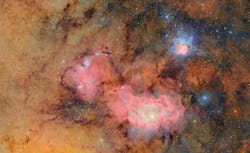NSF-DOE Vera C. Rubin Observatory stuns with ‘first look’ imagery, 3D app
On June 23rd, the NSF-DOE Vera C. Rubin Observatory, located on Cerro Pachón in Chile, certainly didn’t disappoint when it unveiled its first-look imagery of the cosmos. Within 10 hours of observations it discovered 2,104 never-before-seen asteroids inside our solar system—including seven near-Earth asteroids.
To put this into perspective, about 20,000 asteroids are discovered each year by all other ground- and space-based observatories. And Rubin Observatory is expected to discover millions of new ones within the first two years of its 10-year Legacy Survey of Space and Time (LSST), as well as spot interstellar objects as they zoom through the solar system.
What does the first imagery reveal? Stunning cosmic phenomena captured at an unprecedented scale by the 3,200-megapixel LSST camera. The world’s largest astronomical camera images vast swaths of the sky with precision—each image covers an area of sky the equivalent of 45 full moons per image—with its pioneering optical system and streams it into a real-time processing system.
This image of the Trifid nebula (top) and the Lagoon nebula, which are several thousand light-years away from Earth, combines 678 images taken within about seven hours of observing time—and it clearly reveals their faint or otherwise invisible details like clouds of gas and dust.
And an app called 3D Orbitviewer shares Rubin Observatory’s solar system objects/discoveries with everyone—you can explore it all on your own in 3D and real time. The app is designed for mobile phones, tablets, or desktops, and adapts to your device for an optimal viewing experience. It provides access to information about planets, dwarf planets, near-Earth objects, asteroids, trans-Neptunian objects, comets, interstellar objects, and more. Check it out—it’s pretty amazing. You can learn about the overall structure of the solar system by viewing the orbits of each category of object or explore individual objects by clicking the icons. Happy viewing!
About the Author
Sally Cole Johnson
Editor in Chief
Sally Cole Johnson, Laser Focus World’s editor in chief, is a science and technology journalist who specializes in physics and semiconductors.

